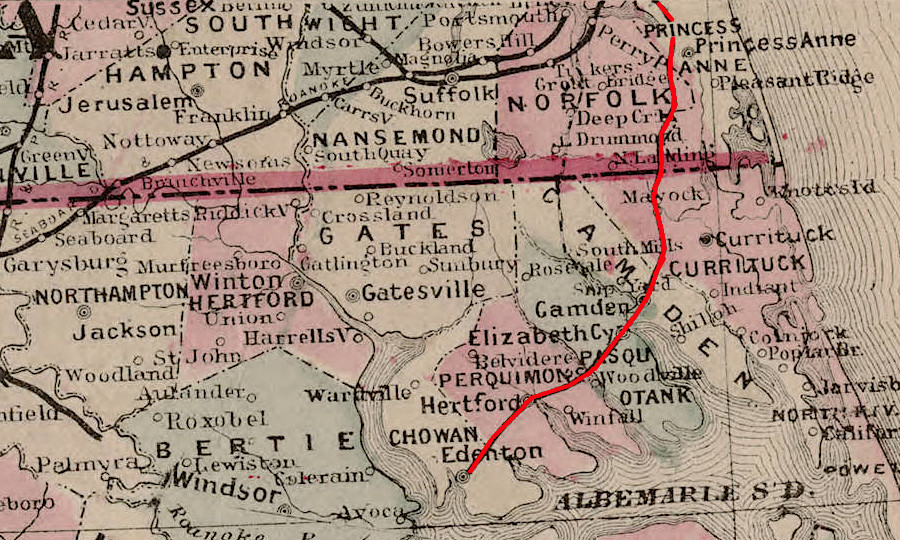
the "original" Norfolk Southern Railroad connected Edenton to Norfolk in the 1880's
Source: University of North Carolina, New railroad and county map of North Carolina (by George Franklin Cram, 1880's)

the "original" Norfolk Southern Railroad connected Edenton to Norfolk in the 1880's
Source: University of North Carolina, New railroad and county map of North Carolina (by George Franklin Cram, 1880's)
The original Norfolk Southern Railroad is a different company from the Class 1 Norfolk Southern operating today. That first Norfolk Southern Railroad operated from 1883 to 1982. The railroad was first named the Norfolk Southern Railroad in 1883, then renamed the Norfolk & Southern Railroad in 1891. The name was changed back to Norfolk Southern Railroad in 1900.
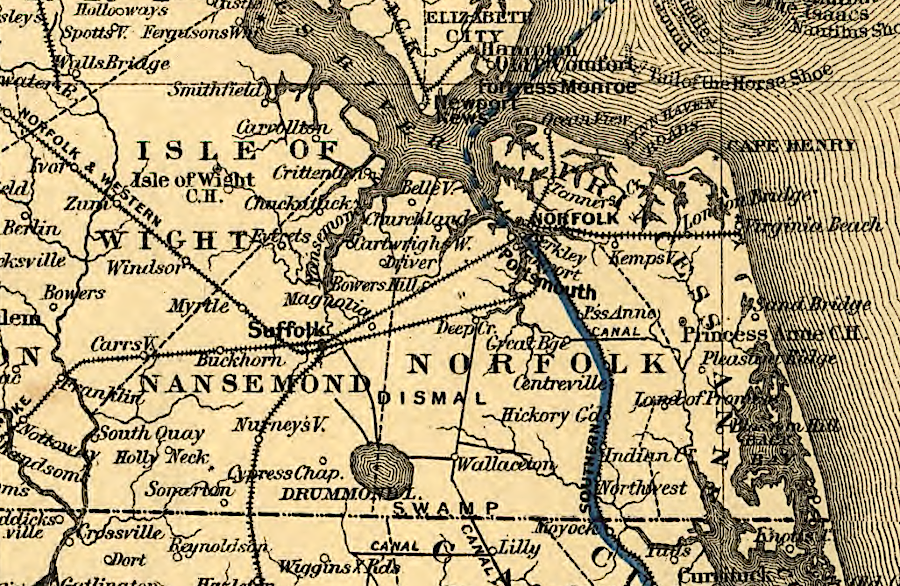
the original Norfolk Southern Railroad in 1887
Source: Library of Congress, Map showing the Albemarle & Pantego Railroad and its connections (c.1887)
It started as the Elizabeth City & Norfolk Railroad Company. That railroad was chartered in 1870, but a decade passed before construction started. The Elizabeth City & Norfolk Railroad completed track connecting Berkeley with Edenton in North Carolina, via Elizabeth City, in 1881. The Berkeley-Edenton track totalled 55 miles, and the Edenton-Elizabeth City segment added an additional 28 miles.
The company's name was changed to "Norfolk Southern Railroad" in 1883.
The original Norfolk Southern line paralleled the Dismal Swamp Canal. It competed with canal boats floating between Edenton and the Chesapeake Bay port of Norfolk. The Albemarle & Chesapeake Canal was another competing option for freight and passengers.
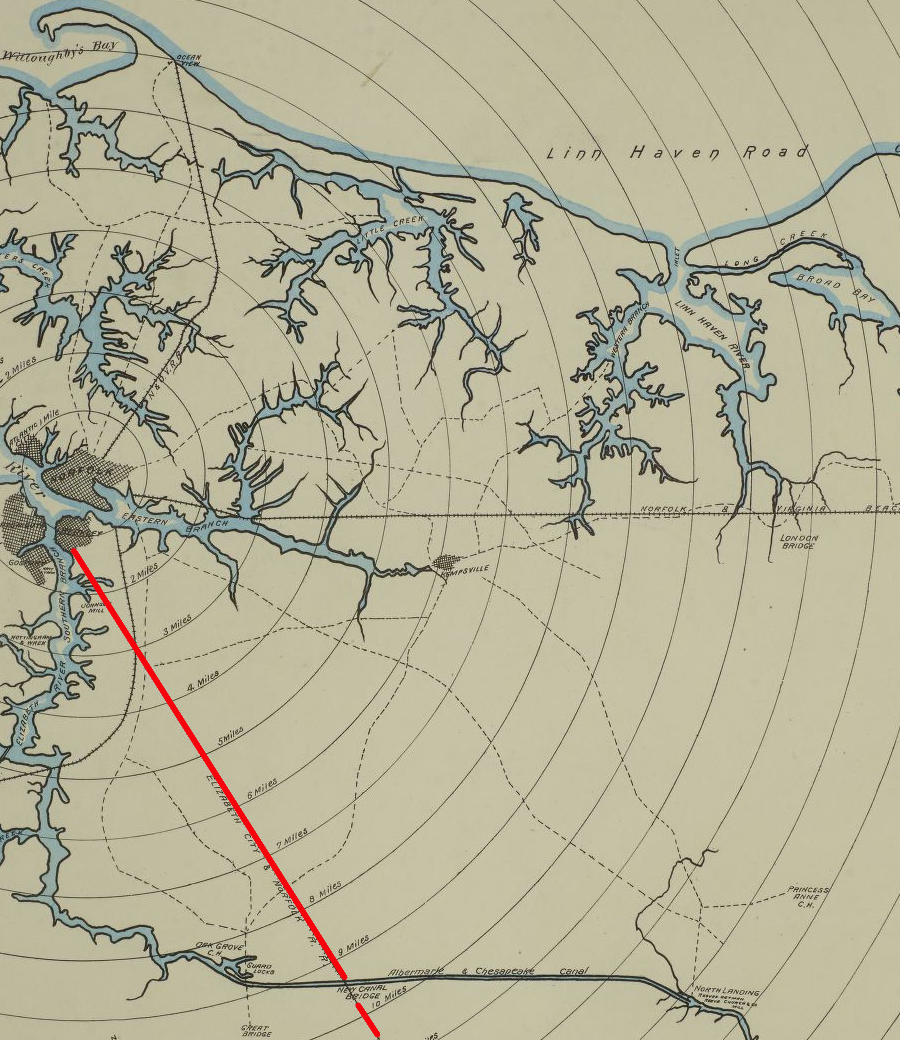
the Elizabeth City & Norfolk Railroad competed with the Dismal Swamp Canal and the Albemarle & Chesapeake Canal
Source: Library of Congress, Sanborn Fire Insurance Map from Norfolk, Independent Cities, Virginia (Sanborn Map Company, 1887)
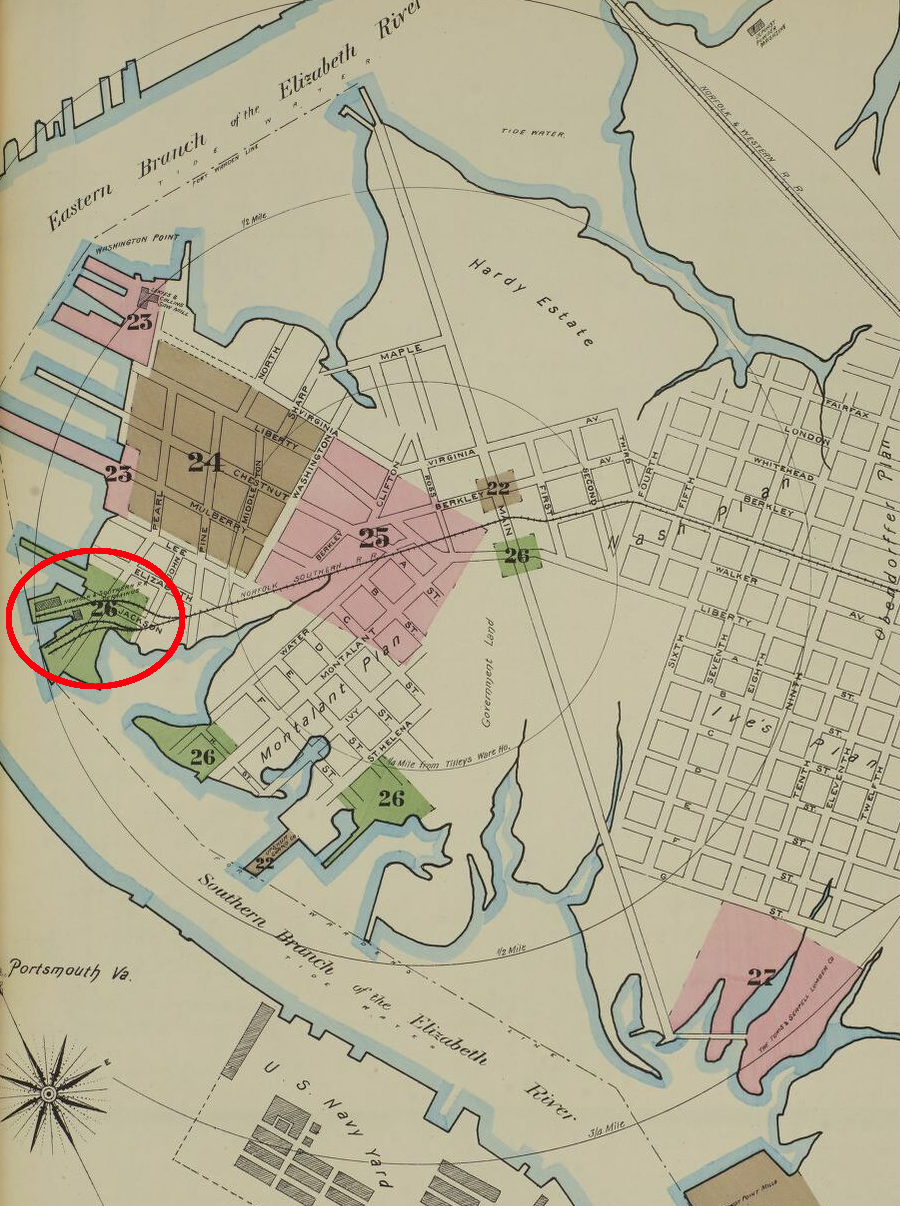
the Elizabeth City & Norfolk Railroad (later Norfolk & Southern) built its northern terminal on the Southern Branch of the Elizabeth River in Berkley
Source: Library of Congress, Sanborn Fire Insurance Map from Norfolk, Independent Cities, Virginia (Sanborn Map Company, 1887)
The Norfolk Southern Railroad went through bankruptcy in 1891, emerging as the Norfolk and Southern Railroad.
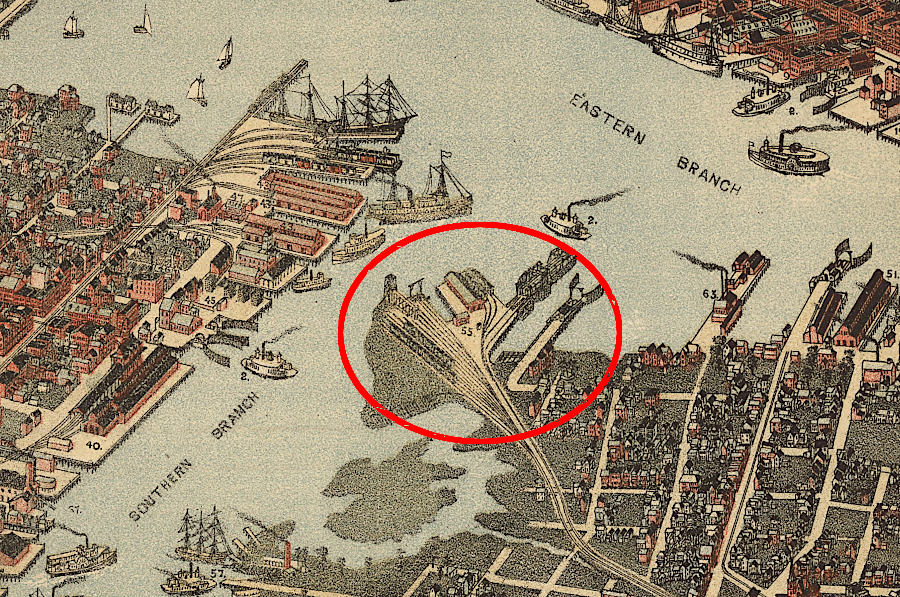
the original Norfolk Southern Railroad depot at Berkley in 1891
Source: Library of Congress, Bird's eye view of Norfolk, Portsmouth and Berkley, Norfolk Co., Va (1891?)
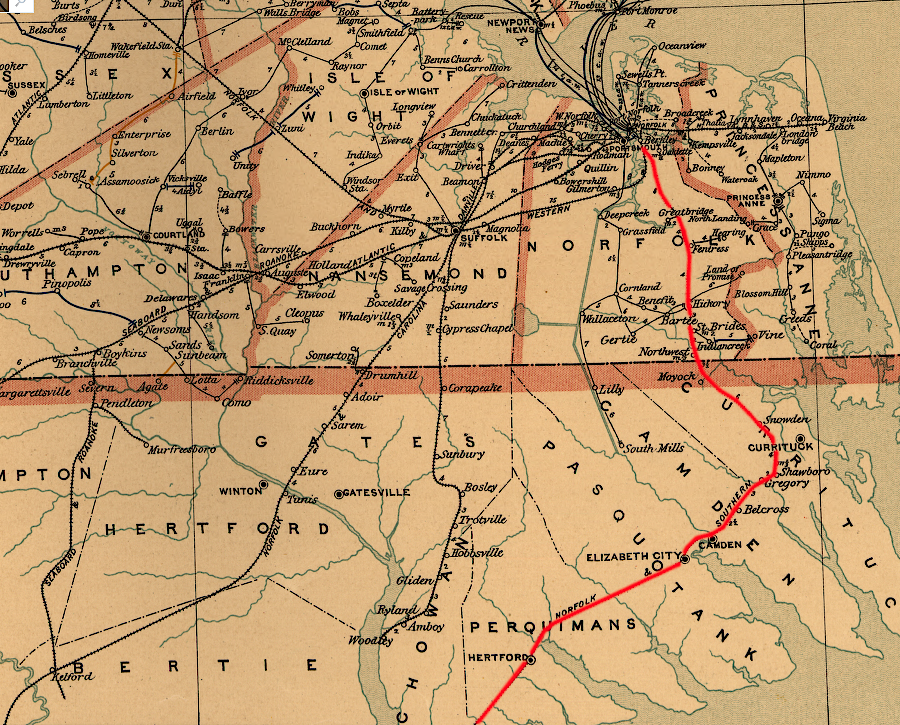
Norfolk and Southern Railroad in 1896
Source: Library of Congress, Post route map of the state of Virginia and West Virginia (1896) To get west of Edenton, the Norfolk Southern purchased the Washington & Plymouth Railroad in 1904. That narrow gauge railroad connected Plymouth on the Roanoke River opposite Edenton to Washington on the Pamlico River. The track was converted to standard gauge in 1905.
The Norfolk Southern Railroad merged with the Raleigh & Pamlico Sound Railroad in 1906, creating the Norfolk & Southern Railway. That merger added track west from Washington, North Carolina to Raleigh. After another bankruptcy in 1908, the company emerged from receivership in 1910 as the Norfolk Southern Railroad. That year, a trestle across Albemarle Sound from Edenton to Mackey's Ferry (and Plymouth) replaced the car ferry.
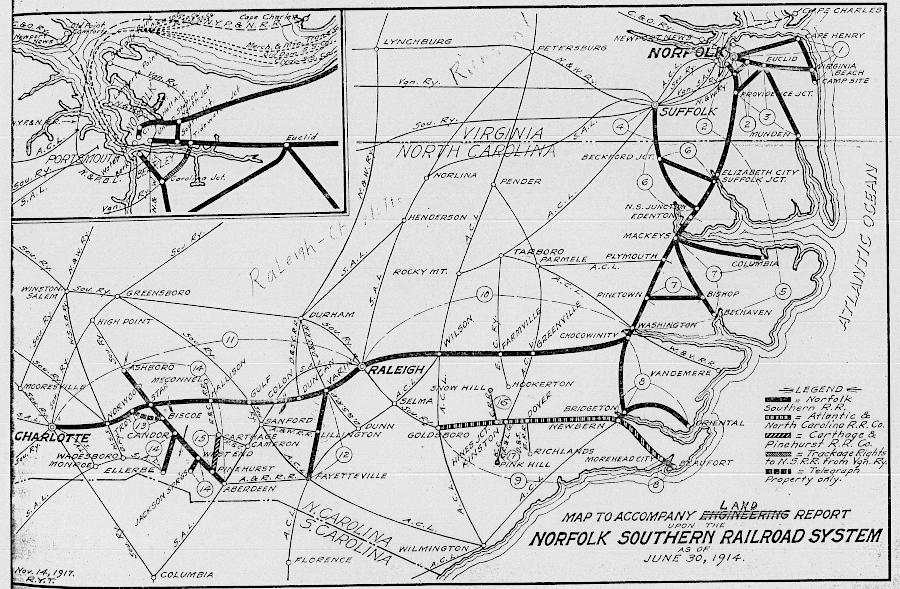
the original Norfolk Southern Railroad linked North Carolina farmland to Chesapeake Bay ports
Source: National Archives, System Index Map - Norfolk Southern Railroad (ca. 1915–ca. 1920)
After another merger in 1916, the Norfolk Southern Railroad's 383-mile mainline linked Norfolk to Charlotte. Another merger in 1920 added track to Durham, North Carolina. At its peak, the railroad had 907 miles of track.1
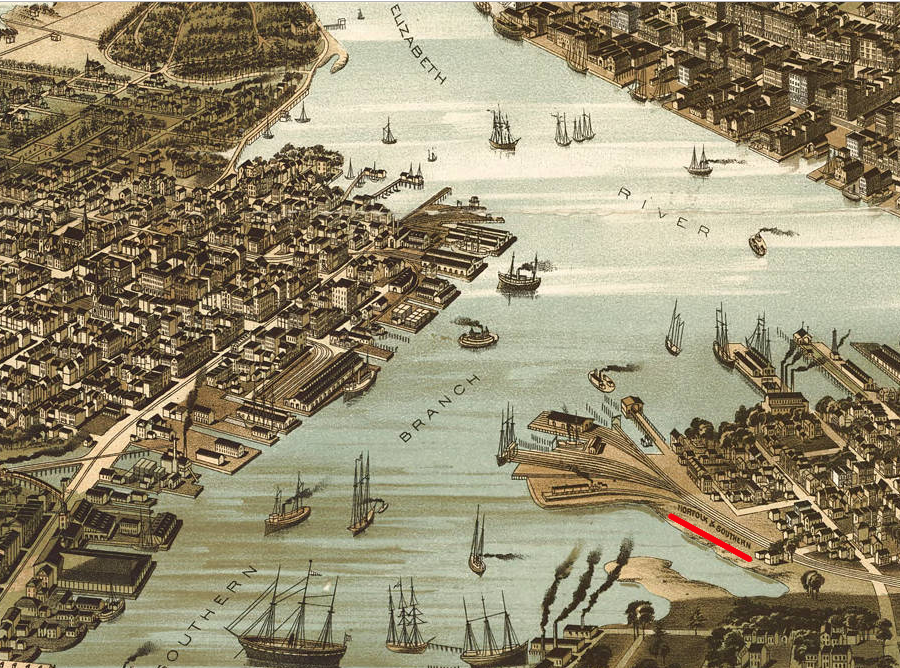
the original Norfolk Southern built a terminal on the Elizabeth River, near the modern portal of the Downtown Tunnel
Source: Norfolk Public Library, Panorama of Norfolk and Surroundings, 1892
When the Norfolk and Southern Railroad acquired the Norfolk, Virginia Beach and Southern Railroad in 1900, the corporate headquarters was located in Norfolk. It stayed there until 1961, when it moved to Raleigh.2
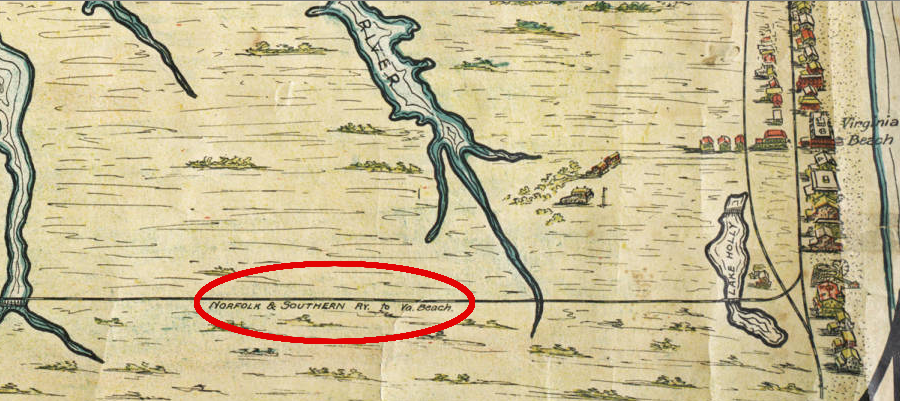
the Norfolk Southern transported passengers to the oceanfront for almost 50 years
Source: Norfolk Public Library, Chesapeake Park Land Development Plan, Princess Anne County, Virginia (1910)
Acquisition of the Norfolk, Virginia Beach and Southern Railroad in 1900 provided a connection to the Atlantic Ocean resort area within Princess Anne County, plus track south to Munden. That line had been built by the Norfolk, Virginia Beach and Southern Railroad in 1898. Various types of passengers rode the Munden line. It was called the "Currituck Branch" and "The Sportsmen's Special" because it carried the wealthy to their hunting clubs near Back Bay and the Atlantic Ocean coastline. Prince Anne residents also called it the "Lawyer's Special," because it passed by the county courthouse. Today that courthouse site has become the city hall for Virginia Beach.
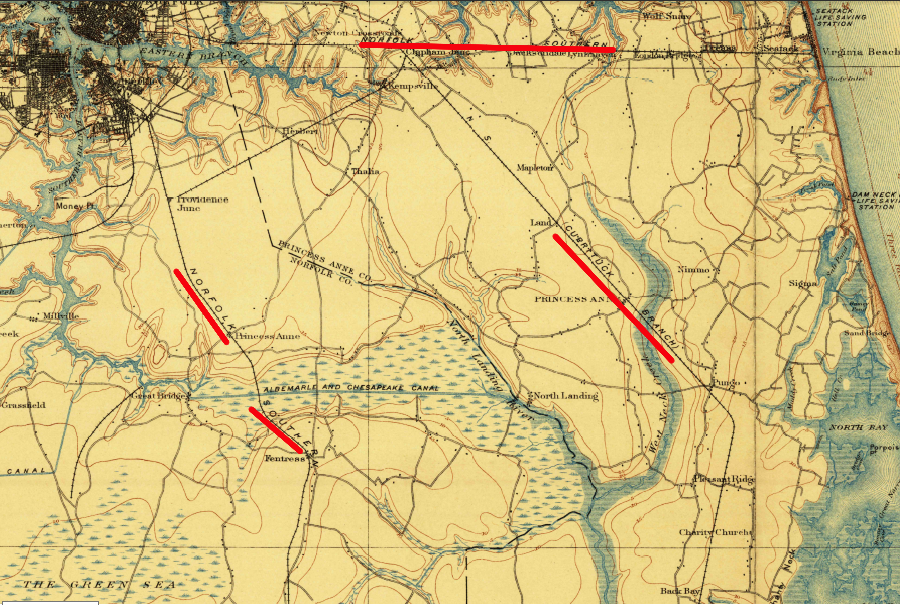
the Currituck Branch of the Norfolk and Southern took hunters and fishermen to Munden
Source: US Geological Survey (USGS), Norfolk, VA 1:25,000 scale topographic quadrangle (1902)
Students used the twice-daily trains of the Norfolk and Southern Railroad to get to the three Princess Anne County high schools at Oceana, Creeds and Kempsville. During World War II, the military used that line to transport men and horses to Munden Point. From the end of the line, they would go to Sandbridge and patrol the shoreline. In addition to scouting for ships in distress, they looked for German infiltrators that might be landed from U-boats.
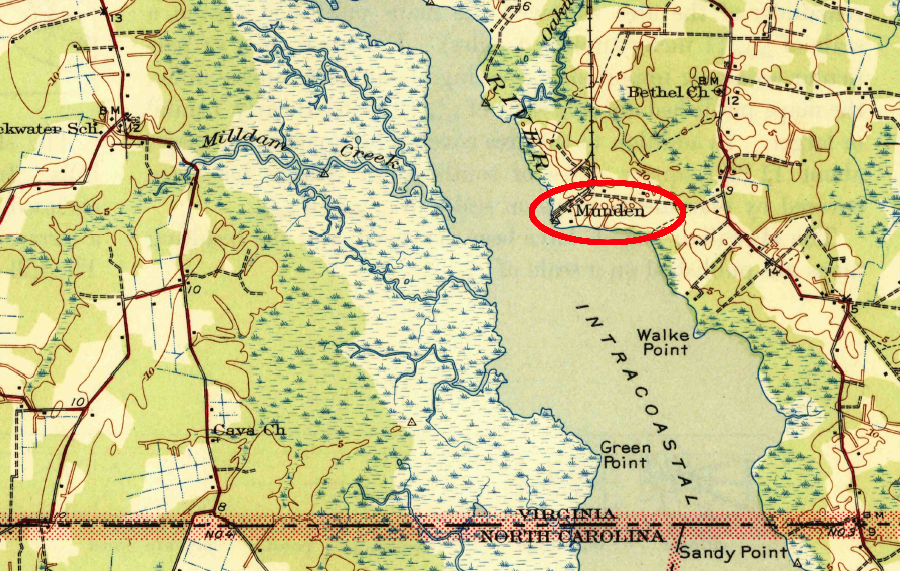
in 1946, a Norfolk Southern branch connected the Norfolk-Virginia Beach line with Munden Point
Source: US Geological Survey (USGS), Moyock VA 1:62,500 scale topographic quadrangle (1946)
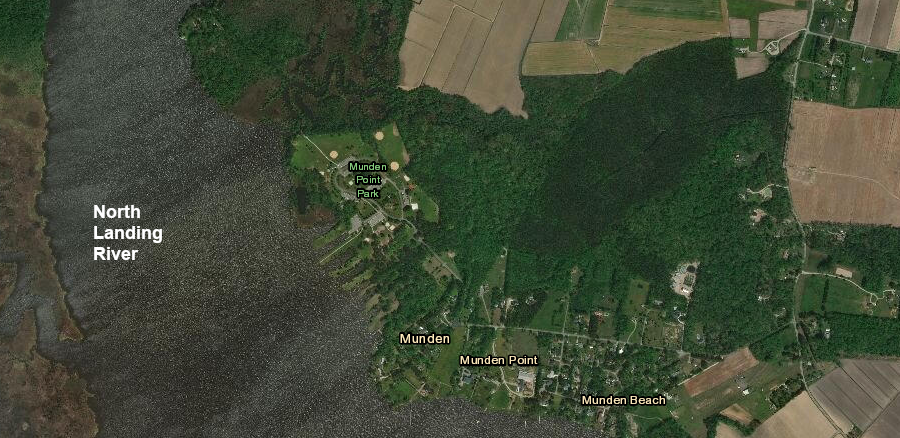
the former end of the railroad is now Munden Point Park
Source: ESRI, ArcGIS Online
The Norfolk and Southern, after purchasing the Norfolk, Virginia Beach and Southern Railroad in 1900, carried passengers to the "Virginia Beach" hotels on the Atlantic Ocean. However, there were two competitors carrying tourists from Norfolk to the waterfront.
The rival Norfolk and Ocean View Railroad took people to the vacation destination of Ocean View on Willoughby Spit. The resort area at Willoughby Spit was on the Chesapeake Bay.
The Chesapeake Transit Company took vacationers from Norfolk to Atlantic Ocean waterfront at Cape Henry, north of the Norfolk Southern line. The Chesapeake Transit Company aimed to develop alternative vacation resort properties at Cape Henry, and at the time the Virginia Beach hotels served by the original Norfolk Southern Railroad were struggling to survive. The extensive forests in "The Desert" at Cape Henry offered revenue-generating freight cargo for the Chesapeake Transit Company, in addition to the tourist business.
The Chesapeake Transit Company built a drawbridge at Lynnhaven Inlet and in 1902 completed an electrified, standard gauge line to Cape Henry. The brick passenger station opened there in 1904. William J. O'Keefe's casino and a dance pavilion at Cape Henry provided entertainment for Norfolk residents making a day trip, while cottages and a hotel provided an overnight option.
After reaching Cape Henry, the Chesapeake Transit Company started to extend its track to go south to the resort area at Virginia Beach. The Chesapeake Transit Company advertised that vacationers should use its route to the oceanfront because its electricity-powered trains were "smokeless," in contrast to the coal-fired locomotives of the Norfolk Southern.
In response, the Norfolk and Southern Railroad started to lay new track next to the Chesapeake Transit Company line, giving tourists two choices for getting to the casino, dance pavilion, and cottages there. The Norfolk Southern also electrified its track from Norfolk to the oceanfront, leveling the playing field for "smokeless" trips.
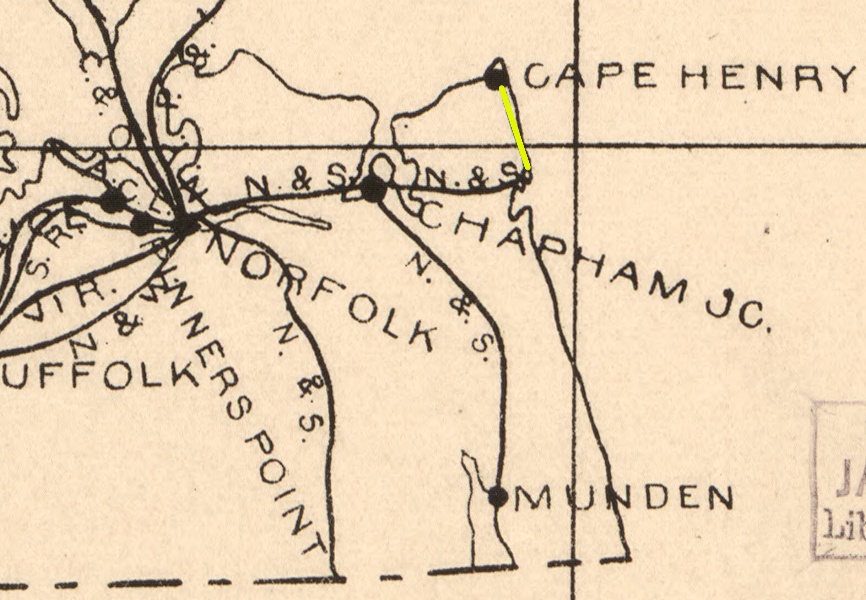
the Norfolk Southern extended its track to Cape Henry in 1902
Source: Library of Congress, Railway mail map of Virginia (Earl P. Hopkins, c.1910)
Rather than complete duplicative lines, the investors in Pittsburgh who owned the Chesapeake Transit Company chose to combine with the Norfolk and Southern. That railroad's ownership had shifted from the Vanderbilts to George Gould, son of the legendary financial speculator Jay Gould. The railroads in Princess Anne County were owned by northern investors, not by Virginia-based capitalists. Their decisions were based on maximizing profits, not on local pride.
The Norfolk and Southern Railroad purchased the Chesapeake Transit Company in 1904. As a result of the merger, vacationers could travel in a loop on electrified lines from Norfolk to Cape Henry, then along the shoreline of the Atlantic Ocean almost to Rudee Inlet before heading west back to Norfolk. The Norfolk and Southern's duplicative track between Virginia Beach-Cape Henry was removed.3
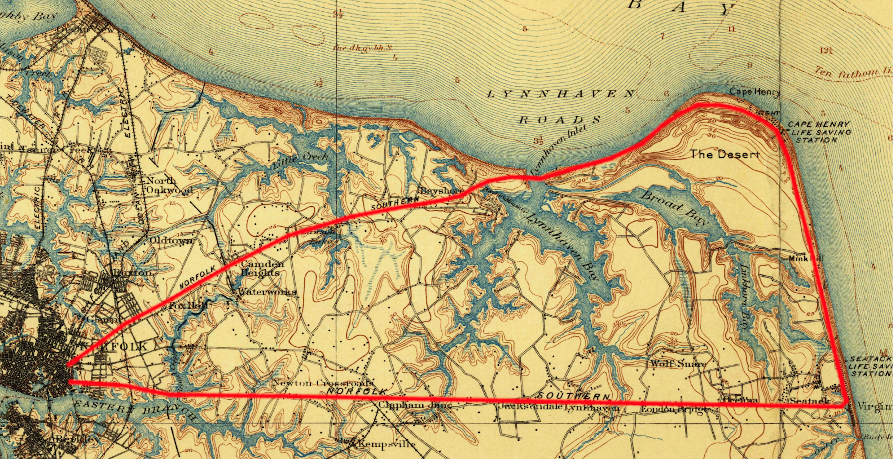
the combination of Chesapeake Transit Company and the Norfolk Southern Railroad in 1904 allowed vacationers to make a loop on the electrified line (red)
Source: US Geological Survey (USGS), Norfolk VA 1:25,000 topographic quadrangle (1902, reprinted 1923)
After the US Army built Fort Story in 1914, the Norfolk and Southern Railway began to transport military passengers and freight to the sand dunes at the Cape Henry lighthouse.4
In 1913, the Norfolk and Southern Railway built a spur to the State Rifle Range which is now Camp Pendleton. Train carried National Guardsmen from Rifle Range Junction to the camp for training.
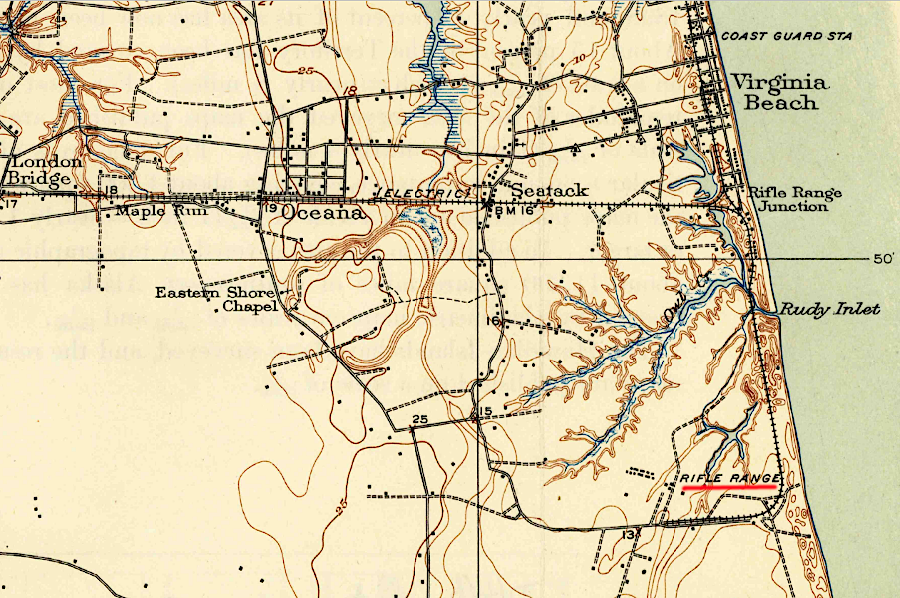
he Norfolk Southern built the Rifle Range spur in 1913
Source: US Geological Survey (USGS), Cape Henry VA 1:62.500 topographic quadrangle (1919)
Another spur on the western edge of Oceana Naval Air Station is now remembered by a local road, Railroad Drive.5
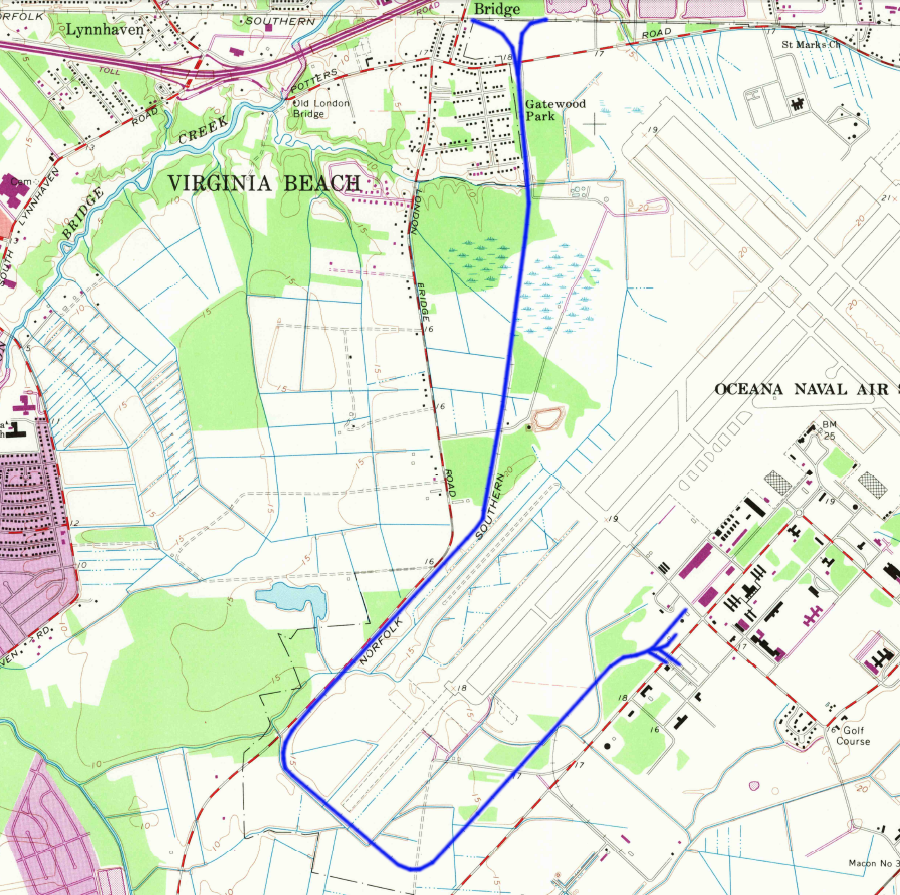
the Norfolk Southern spur on the west side of Oceana in 1965
Source: US Geological Survey (USGS), Princess Anne 1:24,000 topographic quadrangle (1965)
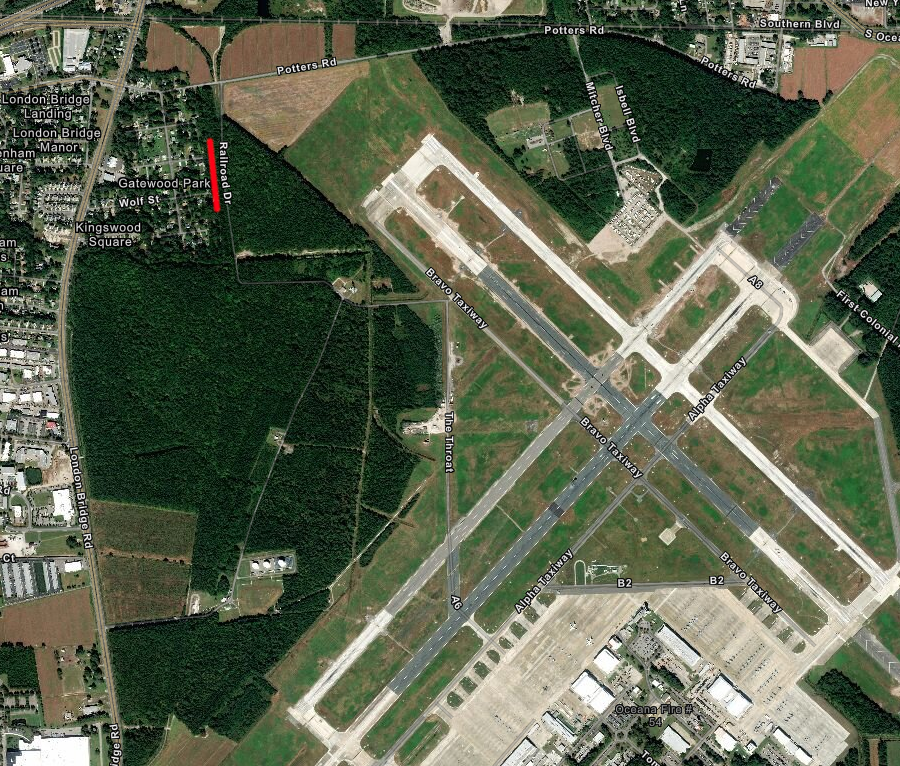
the Norfolk Southern spur is memorialized today by Railroad Drive
Source: ESRI, ArcGIS Online
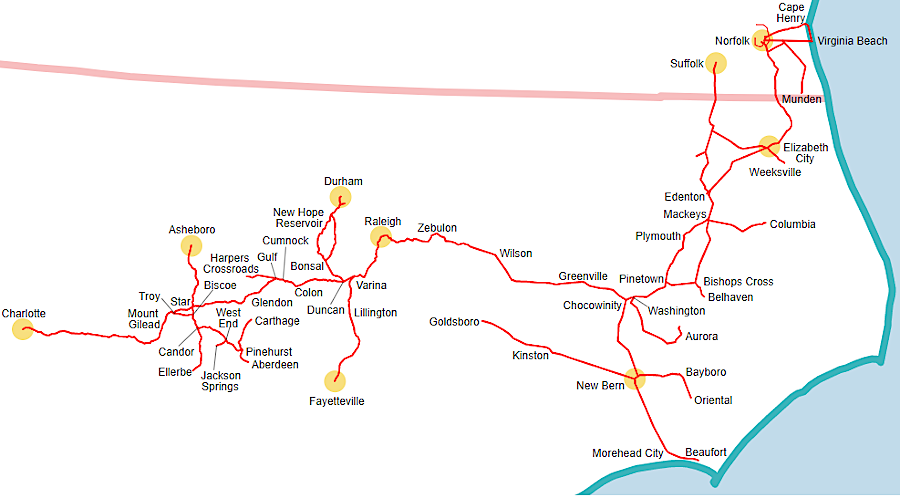
the original Norfolk Southern eventually stretched from Charlotte to Virginia Beach
Source: Wikipedia, Norfolk Southern Railway (1942–1982)
Another bankruptcy led to another reorganization in 1942, with the company renamed the Norfolk Southern Railway. It carried passengers through World War II, but only freight was carried east of Norfolk after 1947. The tracks built from Norfolk to Cape Henry by the Norfolk, Virginia Beach and Southern Railroad were removed in the early 1950's.6
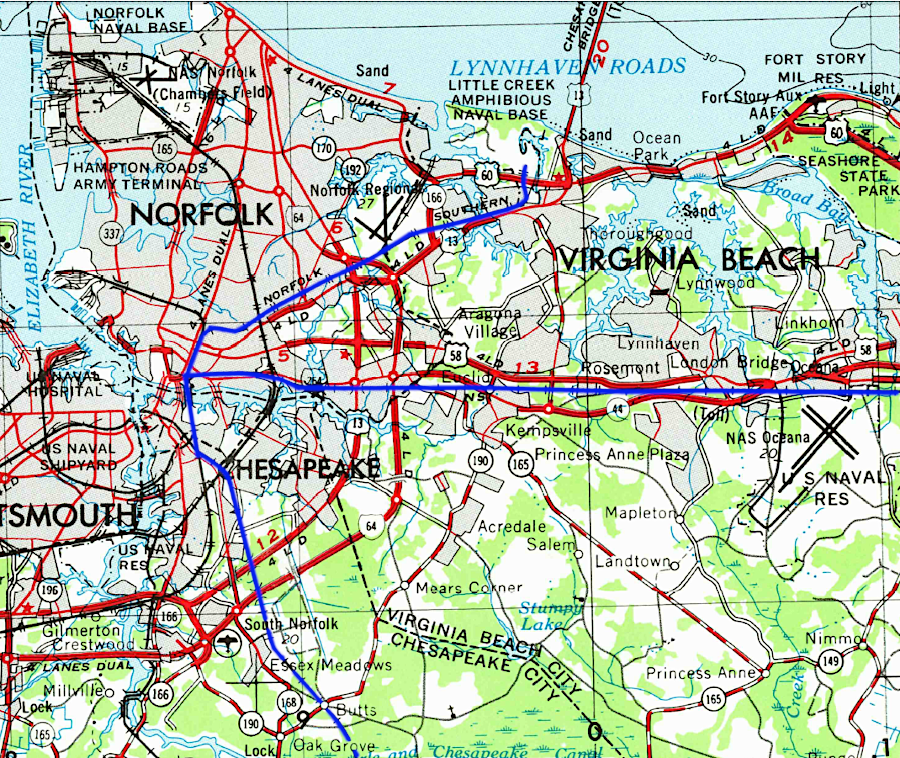
the Norfolk Southern Railway in 1953 (blue) extended to Little Creek and the Oceanfront, but track across Lynnhaven Inlet to Cape Henry had been removed
Source: US Geological Survey (USGS), Norfolk VA 1:250,000 topographic quadrangle (1953)
A 25-mile line between Elizabeth City and the old Suffolk & Carolina Railway at Beckford Junction had been built in 1904. That east-west branch and the old north-south Suffolk & Carolina Railway line between Edenton-Suffolk were abandoned in 1940, victims of the Great Depression. Abandonment of the railroad connection to Suffolk triggered the Camp Manufacturing Company to build the Franklin and Carolina Railroad, in order to get logs from Dismal Swamp to the company's mills in Franklin.7
The Southern Railway acquired the Norfolk Southern Railway in 1974, along with the Carolina and Northwestern Railway. The two lines were merged and operated as the Norfolk Southern Railway.
It was renamed the "Carolina and Northwestern Railroad" for a short time in 1982 becaus the name "Norfolk Southern" was needed for a different, much larger system. In 1982 the Southern Railway and the Norfolk and Western Railroad merged to create the modern Norfolk Southern Railroad. The original Norfolk Southern Railroad, established in 1883, can be considered as a "fallen flag" railroad or as one reborn.8
Some of the original Norfolk Southern track is still in use. The modern Norfolk Southern created a shortline, the Chesapeake and Albemarle Railroad, and leased 69 miles of track between the City of Chesapeake and Edenton, North Carolina.9